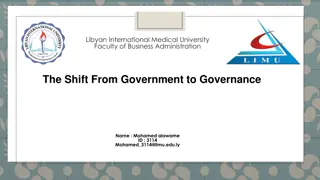Student Engagement in Higher Education Governance: Role of Student Union in Taiwan
Distinguished Professor Sheng-Ju Chan delves into how student unions engage with higher education governance in Taiwan and the crucial role they play. The presentation highlights the support and training required for student engagement in external quality assurance, drawing data from a research project commissioned by the Youth Development Administration, MOE. It discusses the fundamentals and current practices of student unions, emphasizing their involvement in various issues and their influence on decision-making bodies like the University Affairs Council.
Download Presentation

Please find below an Image/Link to download the presentation.
The content on the website is provided AS IS for your information and personal use only. It may not be sold, licensed, or shared on other websites without obtaining consent from the author.If you encounter any issues during the download, it is possible that the publisher has removed the file from their server.
You are allowed to download the files provided on this website for personal or commercial use, subject to the condition that they are used lawfully. All files are the property of their respective owners.
The content on the website is provided AS IS for your information and personal use only. It may not be sold, licensed, or shared on other websites without obtaining consent from the author.
E N D
Presentation Transcript
STUDENT ENGAGEMENT IN HIGHER EDUCATION GOVERNING IN TAIWAN: STUDENT UNION AND ITS CRUCIAL ROLE Distinguished Professor Sheng-Ju Chan Dean for Student Affairs, National Chung Cheng University, Taiwan Adjunct Research Fellow, HEEACT 1
Outline of the presentation How student union/association engages with the higher education governing in Taiwan (IQA)? How student engagement should be supported and trained for external quality assurance? Part of the data taken from the research project commissioned by the Youth Development Administration, MOE
The fundamentals of student engagement: student unions Student Union( ) is NOT a legal entity. It is an internal organization according to Article 33 of the University Act ( ). The Act requires university to help student establishing campus wide union through election. Purpose: as self-governing body ( ) , which is not clearly defined. However, it aims for educational purpose . Legally, there are no differences from other student association, club or societies 3
Current practices: Student unions features and characteristics They are NOT real union but volunteering organization for self- governing. Student pays for membership fee as member of union (non- compulsory) Legally not independent, but financial and operational to be independent within the university (free from the administration and management of the university). Currently, several student unions are keen to position themselves either as student-right centered ( ) or as activities centered ( ) 4
Current focuses For the past three decades, student unions in Taiwan have played significant role in launching protests/strikes in social, cultural, environmental, economic and educational issues. For the former approach, it is highly related to the learning quality assurance for students. Particularly, Student union pays more attentions to the academic rules/regulations ( ), participation into major committees, students accommodation, security, and learning facilities etc. 5
Student engagement and higher education governing Students are authorized by the University Act to participate the University Affairs Council (UAC, ), which is composed of all kinds of representatives. In this critical decision-making body, a minimum of 10% of the members must be students (student unions would like to raise it to 20%). The following factors influence the students engagement with UAC: Time, willingness and professional knowledge. 6
Current forms of student engagement Department level: general committee( ), curriculum committee( ) library committee( ) etc. College level: fewer participation as it used to be a intermediate unit only. Now it is getting important. Student Union mainly targets at the university level participation. University level (except UAC): almost of kind of committees such as financial audit, R&D, academic affairs, gender equality, international activities etc. 7
Initial observation of student engagement Taiwan is increasingly inclusive for student engagement through University Act and internal arrangement of student union at the university level. The student unions at some major universities emphasize student-right centered ( ) while the others face more obstacles and challenges as indicated previously. Nevertheless, program/department evaluation undertaken by HEEACT and TAEA( ) has included student engagement as indicator. 8
Moving from student-right centered to quality assurance 9
UK quality code for student engagement (QAA) Core Practices: The provider actively engages students, individually and collectively, in the quality of their educational experience Common Practices: The provider engages students individually and collectively in the development, assurance and enhancement of the quality of their educational experience 10
Main areas for student engagement (QAA) Recruitment, selection and admissions; Induction and transition into higher education; Course and curriculum design, development and delivery and review; Learning and teaching; Learning opportunities and resources; Student support and guidance; Assessment and feedback; Student progression and achievement. 11
What we have at Internal QA? There are a wide range of engagement channels at department, college and university level. Student unions focus on academic rules/regulations ( ), participation into major committees, health and counseling, labor condition, students accommodation, security, and learning support and facilities etc. These can be broadly regarded as quality assurance issues. 12
Challenges ahead for student as external reviewer at EQA (social agendas)? Rationales and Justifications: why student? EQA as highly professional work Legal status? Not that difficult Cultural barriers? student as immature body reviewer as judge student tends to be regarded as unsuitable Public awareness (no similar example at other public domains) Lack of professional training and experience (talent shortage) Political attitudes 13
Social support and training development for students (practical issues) Time: sabbatical leave (for certain credits/hours), financial support for engagement volunteering Willingness: covering training costs, providing certificate, public recognition/commendation Professional knowledge: training schemes/programs jointly offered by universities and quality assurance agencies (consulting with student union) Engagement channels: as assistant or observer within the review panel 14
Conclusions Take successful lessons from IQA to EQA Adopt an incremental approach for EQA reviewers Policy alignment among government, university and QA agency Sufficient supporting mechanisms and phased strategies in next five to ten years 15























